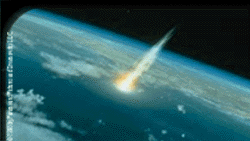
IMPACT : Death from Above

In 1980, Nobel-Prize winning physicist Luis Alvarez and his geologist son Walter rocked the scientific world with their proposal that dinosaurs became extinct as the result of an impact of a huge meteorite. They found iridium in a thin layer of clay that marked the boundary between the Cretaceous and Tertiary geological periods, at the same time as the end of the dinosaurs and the rise of mammals. Because iridium is rare in Earth rocks but abundant in rocks in space such as meteoroids and asteroids, they theorized that the iridium had come from a cosmic impact.
Most scientists now agree that, 65 million years ago, a six-mile-wide asteroid hurtling through space at 15 kilometers/second (9 miles/second), a hundred times faster than a speeding bullet, slammed into the Earth. The resulting explosion, with the force of a hundred million million tons of TNT, threw iridium-enriched dust high into the atmosphere, shutting off sunlight for weeks or months and cooling the planet. Acid rain and wildfires also followed the collision. Plants died, as did many of the animals that ate them.
| Meteorite Impacts | | More About Comet Impact | | The Simulated Effects of a Small Comet |
| What Killed The Dinosaurs?? | | Can Impact Be Prevented |
(c) 1998 William Jessee